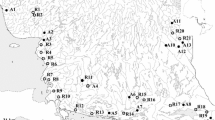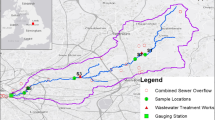Abstract
Great Lakes coastal wetlands are subject to many types of anthropogenic disturbances. Agricultural non-point source pollution is a major contributor to the eutrophication of coastal aquatic systems and agricultural pesticides and herbicides have been linked to losses of wetland biodiversity. Nutrients and pollutants are washed off the landscape during rain events and often times enter drainage systems that are connected to Great Lakes waters. The purpose of this study was to assess the effect that agricultural drainage systems have on coastal wetlands and to measure the subsequent alterations in coastal wetland biota. We sampled coastal wetland sites in Lake Huron and Lake Michigan near (<800 m) the mouth of drainage systems and at sites far (>1500 m) from drainage outlets for habitat conditions, aquatic macroinvertebrates and fish. Non-metric multi-dimensional scaling (NMDS) analysis in conjunction with a multi response permutation procedure (MRPP) revealed differences in macroinvertebrate community compositions located near drainage outlets when compared to sites far from outlets. Principal component analysis (PCA) of 16 abiotic parameters exposed variation in habitat conditions between sites near and far from outlets. Increased levels of nitrates, turbidity, and specific conductance were often associated with sites near outlets. These findings demonstrate the strong impact of agricultural drainage ditches on coastal wetlands and stress the importance of protective land use policy.






Similar content being viewed by others
References
Angradi TR, Hagan SM, Able KW (2001) Vegetation type and the intertidal macroinvertebrate fauna of a brackish marsh: Phragmites vs Spartina. Wetlands 21(1):75–92
Aston RJ (1973) Tubificids and water quality: a review. Environmental Pollution 5(1):1–10
Burton TM, Uzarski DG, Genet JA (2004) Invertebrate habitat use in relation to fetch and plant zonation in northern Lake Huron coastal wetlands. Aquatic Ecosystem Health and Management Society 7:249–267
Burton TM, Stricker CA, Uzarski DG (2002) Effects of plant community composition and exposure to wave action on invertebrate habitat use of Lake Huron coastal wetlands. Lakes & Reservoirs: Research and Management 7:255–269
Carr JF, Hiltunen JK (1965) Changes in the bottom fauna of western Lake Erie from 1930 to 1961. Limnology and Oceanography 10(4):551–569
Cooper MJ, Gyekis KF, Uzarski DG (2012) Edge effects on abiotic conditions, zooplankton, macroinvertebrates, and larval fishes in Great Lakes fringing marshes. Journal of Great Lakes Research. doi:10.1016/jglr.2011.12.011
Corkum LD (2010) Fishes of essex county and surrounding waters. University of Windsor, Friesens Corporation, Altona, Manitoba
Crowder LB, Cooper WE (1982) Habitat structural complexity and the interaction between bluegills and their prey. Ecology 63(6):1802–1813
Cummins KW (1973) Trophic relations of aquatic insects. Annual Review of Entomology 18:183–206
Dance KW, Hynes HBN (2003) Some effects of agricultural land usage on stream insect communities. Environmental Pollution 22(1):19–28
Egerson CJ, Kopaska JA, Downing JA (2004) A century of change in macrophyte abundance and composition in response to agricultural eutrophication. Hydrobiologia 524:145–156
Gleason RA, Euliss NH, Hubbard DE, Duffy WG (2003) Effect of sediment load on the emergence of aquatic invertebrates and plants from wetland soil egg and seed banks. Wetlands 23(1):26–34
Goodyear CD, Edsall TA, Ormsby-Dempsey D, Moss GD, Polanski PE (1982) Atlas of spawning and nursery areas of Great Lakes fishes. Vol. 1-A summary of geographic area. FWS/OBS-82/52. U.S. Fish and Wildlife Service, Washington, D.C.
Groffman PM (1994) Denitrification in freshwater wetlands. Current Topics in Wetland Biogeochemistry 1:15–35
Harding JS, Young RG, Hayes JW, Shearer KA, Stark JD (1999) Changes in agricultural intensity and river health along a river continuum. Freshwater Biology 42:345–357
Havens KE, James TR, East TL, Smith VH (2003) N:P ratio, light limitation, and cyanobacterial dominance in a subtropical lake impacted by non-point source nutrient pollution. Environmental Pollution 122:379–390
Hough RA, Fornwall MD, Negele BJ, Thompson RL, Putt DA (1989) Plant community dynamics in a chain of lakes: principle factors in the decline of rooted macrophytes with eutrophication. Hydrobiologia 173(3):199–217
Howard-Williams C (1985) Cycling and retention of nitrogen and phosphorus in wetlands: a theoretical and applied perspective. Freshwater Biology 15(4):391–431
Janse JH, Van Puijenbroek PJTM (1998) Effects of eutrophication in drainage ditches. Environmental Pollution 102(1.1.):547–552
Johansson L, Persson L (1986) The fish community of temperate eutrophic lakes. Carbon Dynamics in Eutrophic Temperate Lakes 11(6.119):237–266
Jones JI, Young JO, Eaton JW, Moss B (2002) The influence of nutrient loading, dissolved inorganic carbon and higher trophic levels on the interaction between submerged plants and periphyton. Journal of Ecology 90:12–24
Jude DJ, Pappas J (1992) Fish utilization of Great Lakes wetlands. Journal of Great Lakes Research 18:651–672
Kashian DR, Burton TM (2000) A comparison of macroinvertebrates of two Great Lakes coastal wetlands: testing potential metrics for an index for ecological integrity. 26(4):460–481
King DL, Ball RC (1964) A quantitative biological measure of stream pollution. Journal Water Pollution Control Federation 36(5):650–653
Klotz RL (1985) Factors controlling phosphorus limitation in stream sediments. Limnology and Oceanography 30(3):543–553
Matthews WJ, Maness JD (1979) Critical thermal maxima, oxygen tolerances and success of cyprinid fishes in a southwest river. American Midland Naturalist 102(2):374–377
McDowell RW, Wilcock RJ (2004) Particulate phosphorus transport within stream flow of an agricultural catchment. Journal of Environmental Quality 33(6):2111–2121
Melzner A (1999) Aquatic macrophytes as tools for lake management. Hydrobiologia 395–396:181–190
Merritt RW, Cummins KW (1996) An introduction of the aquatic insects of North America. Third Edition. Kendall/Hunt Publishing Company
Michael JH (2003) Nutrients in salmon hatchery wastewater and its removal through the use of a wetland constructed to treat off-line settling pond effluent. Aquaculture 226(1/4):213–225
Michigan DNR (2009) http://www.michigan.gov/dnr/0,1607,7-153-10364---,00.html October 19, 2009
Olsen EJ, Engstrom ES, Doeringsfield MR, Bellig R (1995) Abundance and distribution of macroinvertebrates in relation to macrophyte communities in a prairie marsh, Swan Lake, Minnesota. Journal of Freshwater Ecology 10(4):325–335
Peckarski BL, Fraissinet PR, Penton MA, Conklin DJ (1990) Freshwater macroinvertebrates of northeastern North America. Comstock Publishing Associates
Prince HH, Padding PI, Knapton RW (1992) Waterfowl use of the Laurentian Great Lakes. Journal of Great Lakes Research 18:673–699
Rabalais NN (2002) Nitrogen in aquatic systems. Ambio: A Journal of the Human Environment 31(2):102–112
Randall RG, Minns CK, Cairns VW, Moore EJ (1996) The relationship between an index of fish production and submerged macrophytes and other features at three littoral areas in the Great Lakes. Canadian Journal of Fisheries and Aquatic Sciences 53(S1):35–44
Relyea RA (2005) The impact of insecticides and herbicides on the biodiversity and productivity of aquatic communities. Ecological Applications 15(2):618–627
Resources Inventory Committee. (1999) British Columbia Estuary mapping system. Land use coordination office for the coastal task force report, resources inventory committee, Victoria B.C
Rouse JD, Bishop CA, Struger J (1999) Nitrogen pollution: an assessment of its threat to amphibian survival. Environmental Health Perspectives 107(10):799–803
Sharpley AN, Withers PJ (1994) The environmentally-sound management of agricultural phosphorus. Fertilizer Research 39:133–146
Stone ML, Whiles MR, Webber JA, Williard KWJ, Reeve JD (2005) Macroinvertebrate communities in agriculturally impacted southern Illinois streams: patterns with riparian vegetation, water quality, and in-stream habitat quality. Journal of Environmental Quality 34:907–917
Svengsouk LJ, Mitsch WJ (2001) Dynamics of Typha latifolia and Schoenoplectus tabermontani in nutrient enrichment wetland experiments. 145(2): 309–324
Tammi J, Lappalainen A, Mannio J, Rask M, Vourenmaa J (1999) Effect of eutrophication on fish and fisheries in Finnish lakes: a survey based on random sampling. Fisheries Management and Ecology 6(3):173–186
Taft OW, Haig SM (2005) The value of agricultural wetlands as invertebrate resources for wintering shorebirds. Agriculture, Ecosystems & Environment 110(3/4):249–256
U.S. Environmental Protection Agency. (2011) http://www.epa.gov/solec/indicator_sheets/coastal_wetlands.pdf November 7, 2011
Whitten BK, Goodnight CJ (1966) Toxicity of some common insecticides to tubificids. Journal Water Pollution Control Federation 38(2):227–235
Uzarski DG, Burton TM, Genet JA (2004) Validation and performance of an invertebrate index of biotic integrity for Lakes Huron and Michigan fringing wetlands during a period of lake level decline. Aquatic Ecosystem Health and Management Society 7(2):269–288
Uzarski DG, Burton TM, Cooper MJ, Ingram JW, Timmermans ST (2005) Fish habitat use within and across wetland classes in coastal wetlands of the five Great Lakes: Development of a fish-based index of biotic integrity. Journal of Great Lakes Research 31(1):171–187
Uzarski DG, Burton TM, Kolar RE, Cooper MJ (2009) The ecological impacts on fragmentation and vegetation removal in Lake Huron’s coastal wetlands. Aquatic Ecosystem Health and Management Society 12:1.45–62
Vannote RL, Minshall WG, Cummins KW, Sedell JR, Cushing CE (1980) The river continuum concept. Canadian Journal of Fisheries and Aquatic Sciences 37(1):130–137
Webb NR, Clarke RT, Nicholas JT (1984) Invertebrate diversity on fragmented Calluna-heathland: effects of surrounding vegetation. Journal of Biogeography 11:41–46
Whitt MB (1996) Avian breeding use of coastal wetlands on the Saginaw Bay of Lake Huron. M.S. Thesis. Department of Fisheries and Wildlife, Michigan State University, East Lansing
Wilcox DA (1995) The role of wetlands as nearshore habitat in Lake Huron. In: Munawar M, Edsall T, Leach J (eds) The lake huron ecosystem, fisheries and management. SPB Academic Publishing, Amsterdam, pp 223–245
Yan W, Yin C, Tang H (1997) Nutrient retention by multipond system: mechanisms for the control of nonpoint source pollution. Journal of Environmental Ecology 27(5):1009–1017
Acknowledgments
The concepts and ideas presented here have been made possible as a result of the efforts and ideas put forth by many lab members including Cody Webster, Dave Coulter, Jessica Sherman, Tom Clement, Ryan Wheeler, Chad Blass, Carli Gurholt, Sean Green, Mike O’Leary, Jack Distel, Sasha Bozimowski, and Nicole Schmidt. Funding for this project was provided by the Michigan Department of Environmental Quality and the United States Environmental Protection Agency as part of the Great Lakes Restoration Initiative under proposal EPAGLNPO-2010-H-3-984-758 titled GLIC: Implementing Great Lakes Coastal Wetland Monitoring.
Author information
Authors and Affiliations
Corresponding author
Rights and permissions
About this article
Cite this article
Schock, N.T., Murry, B.A. & Uzarski, D.G. Impacts of Agricultural Drainage Outlets on Great Lakes Coastal Wetlands. Wetlands 34, 297–307 (2014). https://doi.org/10.1007/s13157-013-0486-x
Received:
Accepted:
Published:
Issue Date:
DOI: https://doi.org/10.1007/s13157-013-0486-x




